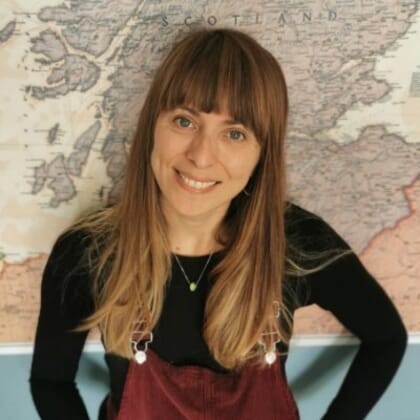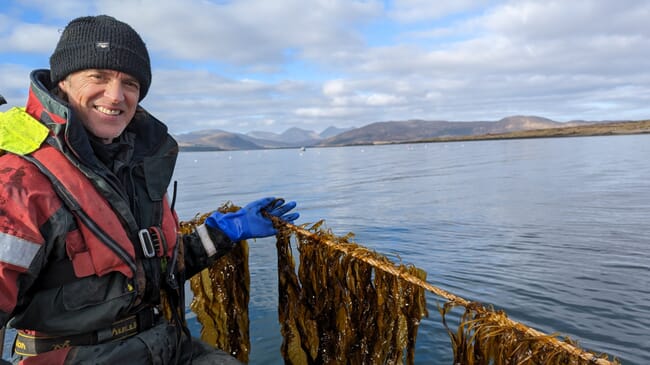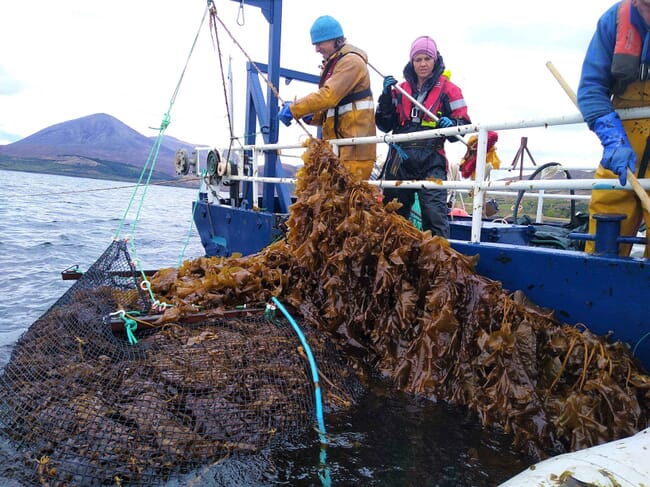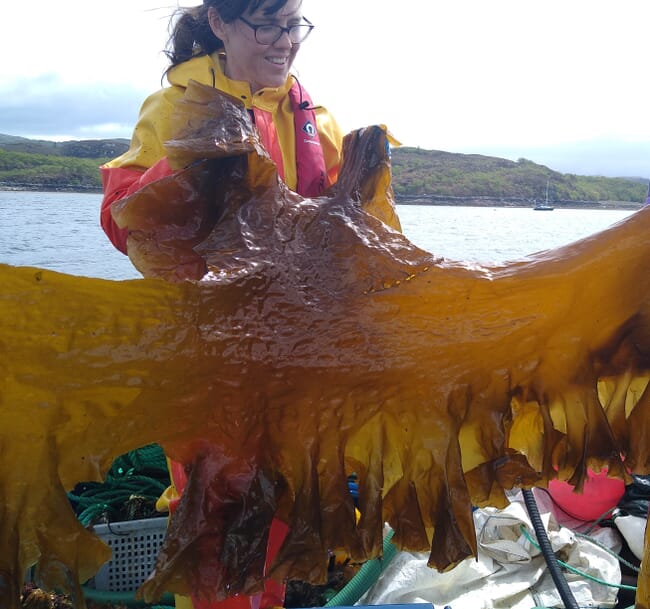
Dr Spatharis's project is exploring environmental DNA (eDNA) to predict biofouling and planktonic threats.
Led by Dr Sofie Spatharis, the aim of the project is to create an early warning system for the onset of biofouling events, so that appropriate management strategies can be implemented on seaweed farms, while she is also looking into using the tool to detect planktonic threats to salmon farms.
Can you briefly outline the aims of your project’s use of eDNA as a tool for avoiding biofouling on seaweed?
Seaweed aquaculture is mostly practised in Asia so far, but is currently expanding along the UK coast too. Production is limited in these UK locations; one reason is because other organisms – usually other algae species or invertebrates – can settle and grow on the cultivated seaweed, a process known as biofouling.
Some biofouling animals can be difficult or impossible to remove during processing, and some [such as small crustaceans] can also cause allergies to consumers. If farmers do not manage to harvest their crop before these organisms settle, then it may not be suitable for the manufacture of certain food and nutrition products. These problems lead to reduced product value, increased processing costs and possible public health issues. As such, the production of food-grade kelp from seaweed farms in the UK can be limited. So our seaweed project aims to find a solution to this issue.

Kelpcrofting is a Scottish seaweed farming startup that is participating in the eDNA project © Kelpcrofting
Currently, are there any widely accessible tools to help seaweed farmers to avoid biofouling?
Not that I am aware of, but perhaps in other areas of the world, where seaweed aquaculture is much more large-scale, they have been able to identify, through experience, ways to avoid it. This could be through timing [of production cycles] and selection of tolerant species and sites that are less subject to the settlement of biofouling species, as these settle from the plankton at the larval or spore stage. In places where seaweed aquaculture has occurred for hundreds of years, it might be that they have identified ways that biofouling can be minimised. This is where our research comes in: we are trying to find the best windows of opportunity; the best species to culture; the best sites for farmers to minimise these problems.
How are you testing the use of eDNA as a tool for avoiding biofouling of cultured seaweed?
We are collaborating with Kelpcrofting, a Scottish seaweed farming startup and we have followed the full production period – from the moment of seeding to the moment of harvesting. We are monitoring the growth of seaweed and biofouling species, as well as the occurrence of the biofouling organisms in the plankton in water samples to be able to see the time-lag from when the organisms are present in the plankton to when they begin to infest and cause issues to the seaweed. We used visual observations, alongside eDNA analysis, as some of these planktonic stages of biofouling organisms are not detectable using a microscope, so having a molecular way to identify these would be a super solution to the problem, as it would inform us when they appear, and when they begin to cause problems. eDNA is helping us do what microscopy cannot do.
Can you briefly describe your research into using eDNA detection of planktonic threats to fish farms?
That is being led by my colleague, Dr Martin Llewellyn, and aims to use eDNA to identify pathogens that pose a threat, not only to farmed salmon, but also to other farmed fish, shellfish or seaweed. Again, there are many planktonic agents that can settle on – and be harmful to – the gills of the fish. Or, if absorbed by shellfish, they can cause toxic symptoms to consumers.
All of these create problems of [increased] mortality, public health issues, reduced product value and in general do not help the viability of these industries. Using eDNA, we are trying to identify the presence of these organisms in the plankton, and identify timelags [between organism appearance and the onset of harmful effects]. If we can develop specific markers to molecularly identify these organisms that cause major problems, and incorporate them into a filter paper-based device, we basically have an early warning system where farmers themselves would be able to dip this device in the water, and see if these threats are present. The device would contain the molecular markers for a given planktonic species, and would detect presence or absence, when dipped in a sample. We are running this project in collaboration with the university’s School of Engineering.
There are multiple planktonic threats to aquaculture, will the device be able to test for multiple pathogens?
The device will be specific to one species, but the goal is to have multiple devices specific for different species [the diatom Pseudo-nitzschia, for example, which releases toxins responsible for amnesic shellfish poisoning; or Paramoeba perurans - the pathogen responsible for amoebic gill disease (AGD) in farmed salmonids].
eDNA analysis can be expensive, so will your device increase accessibility to predictive tools for small startups and farms?
Yes, as the device tests for one organism at a time, the cost is reduced. Additionally samples do not need to be sent away [the device will be used in-situ], and you do not need to pay for sequencing costs, but it is of course less advantageous as there may be other species present that would not be tested for. However, we can test for the most dominant and problematic species at each site, so each location could choose their own [target species], that is the long-term plan.

The researchers are monitoring the growth of seaweed and biofouling species, and tracking the occurrence of the biofouling organisms in the plankton in water samples. © Kelpcrofting
Do you have a working model of the device?
We do not currently have a working model, as we are currently trying to align our eDNA approach with the actual morphological data, this is where we are right now. Developing a working model is the plan for after this stage though, with commercialisation of the device being a long-term goal, but speculation on when this will be is impossible.
eDNA is not always 100 percent accurate, and there is a degree of uncertainty in its results. Is there a way you intend to address this uncertainty for the use of the device?
This is exactly our concern and what we are trying to address with this project, by aligning our eDNA results with morphological observations, as we have samples from both sources over a long period of time on a daily basis, and by aligning these two we can see if what is present in the eDNA aligns with what we identified in plankton using the microscope. If this does not work, then we first need to improve that, and to make them align and then proceed with the paper-based approach.

Spatharis believes we should be finding ways to incorporate seafood into our diets and work with the macroalgae industry to make production profitable. © Kelpcrofting
Aside from research, do you have any personal opinions on seaweed farming and its potential?
We already know that it can be part of human nutrition and recipes but also many other products, such as animal feeds, carrageenan and alginates. I don’t think that so far we have incorporated it as well as we can into our everyday life in the West. Yes, we might eat the occasional sushi, but it can be much more than that.
Because it is super tasty and nutritious, we need to be finding ways in parallel with production that it can be incorporated into our nutrition, and these need to be developed hand-in-hand [with the industry] to make it profitable and worthwhile for the startups that are starting to cultivate it now. In the UK there is currently a lack of funding for different types of aquaculture, such as macroalgae and microalgae. Although both of these are being boosted elsewhere, in the UK we are still in the early stages.




